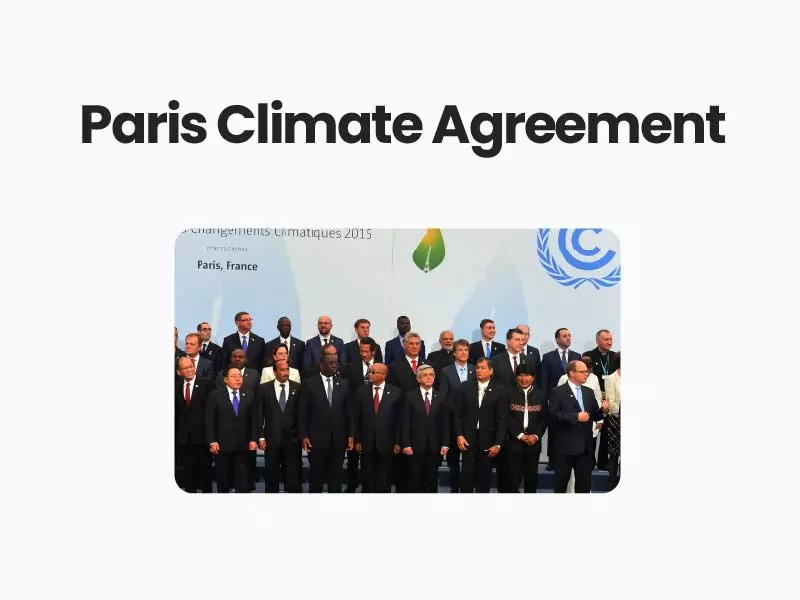
Paris Climate Agreement
Recently in news
In the run-up to two key UN summits on Climate Change, India has raised the pitch for finance and technology support to develop nations to achieve the Paris Agreement goals of keeping a global average temperature rise this century well below 2 degrees Celsius.
Paris agreement?
The 21st session of the Conference of the Parties (COP21) of the United Nations Framework Convention on Climate Change (UNFCCC) was held in Paris from November 30 to December 12, 2015, that saw the participation of 195 nations. The nations negotiated and adopted the Paris Agreement.
The outcome of the Paris conference?
Even if all the commitments made by countries for the Paris Agreement are achieved, the world will still be on a course to warm by more than 3°C this century.so,
- The Nationally Determined Contributions (NDCs) was planned ahead of the Paris COP-21.
- Under this, each country described the actions it would take and the levels to which GHG emissions would be reduced (mitigation).
- Countries also described what they would do to improve their capacity to live in a warmer world (adaptation).
- The extent to which these goals required support in the form of finance or technology transfer was also mentioned.
- The Paris Agreement (PA) was ratified rapidly and went into force within a year (in November 2016).
- The Katowice meeting’s objective is to set guidelines, or agree on a rulebook, to implement pledges made by countries at the Paris Climate Conference in 2015.
Major concerns
- Finance – There has been little if any, progress on finance, technology transfer and capacity development.
- Article 9 of the PA calls for financial support from developed countries that is significantly derived from public funds.
- This was expected to result in at least $100 billion per year to address mitigation and adaptation needs of developing countries.
- Article 9.5 requires developed countries to communicate their levels of support, including pledges of additional finance.
- Even a rough estimate of financial needs for implementing all the NDCs puts it at $4.4 trillion.
- But the Climate Funds Update of 2018 notes that multilateral funds pledged until 2017 are less than $30 billion.
- There have also been charges of double counting and counting of development aid levelled against developed countries.
- Response – While the U.S. and its current policies are much to blame for the situation, other developed countries are not doing that much better.
- Australia and France have had political turmoil due to their climate policies even while experiencing severe weather events.
- Europe is still heavily reliant on coal and European Union emissions were stable in 2014-2016.
- The U.K. has been relying on fuel from fracking.
Also, Read Terrorism Financing
How does the future look?
- The implementation of the activities for the PA formally begins in 2020 and concludes in 2030.
- The world is currently in the Doha Amendment period, or the second phase of the Kyoto Protocol, which has not been ratified.
- In a couple of years after the start of the PA implementation, there will be a review on progress and decisions on more stringent targets for the future.
- This renewed commitment towards the future means that countries have to trust each other.
- So fulfilling obligation is a foundation of future ambition and action.
India and Paris agreement
India had ratified the Paris Agreement on India made four commitments, including:
- Reducing greenhouse gas emission intensity of its GDP by 33-35 per cent below 2005 levels by 2030, under its Nationally Determined Contributions (NDC).
- Pledged that 40 per cent of India’s power capacity would be based on non-fossil fuel sources and that the country will create an additional ‘carbon sink’ of 2.5 to 3 billion tonnes of carbon dioxide equivalent through additional forest and tree cover by 2030.
- The country had decided to better adapt to climate change by enhancing investments in development programmes in sectors vulnerable to climate change, particularly agriculture, water resources, Himalayan region, coastal regions, health and disaster management.
India had ratified the Paris agreement on climate change in 2016 to become the 62nd nation to join the deal.
Way Ahead
- What is required for India is credible, accurate and verifiable numbers on the climate flows expected from developed countries.
- Such a reliable flow will encourage and persuade all countries that commitments made will be fulfilled.
- There also has to be a general agreement on how to estimate adaptation.
- Countries with high emissions should alter their lifestyles considerably, for the transformational change that 1.5 Degree Report calls for.
- As extreme events are on the rise, the separate stream referred to as “loss and damage” needs attention.
- This is a provision for support to poor countries experiencing economic and non-economic losses and destruction from climate change events.
- In advance of the 2020 deadline for countries to raise their commitments in their national climate plans, the focus is given to practical initiatives to limit emissions and build climate resilience. Especially the driving action in six areas; namely, energy transition, climate finance and carbon pricing, industry transition, nature-based solutions, cities and local action, and resilience.
Enroll today with the best civils service academy and take your first step towards your Civils journey.
Feel free to reach out to us for any inquiries, collaborations, or support. We’re here to help.

